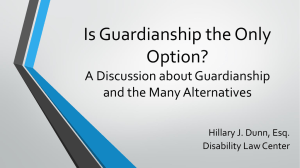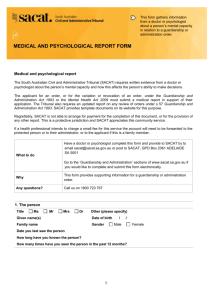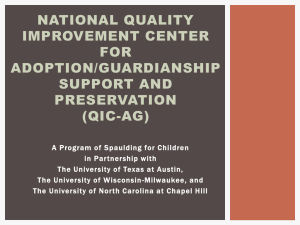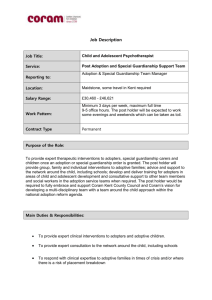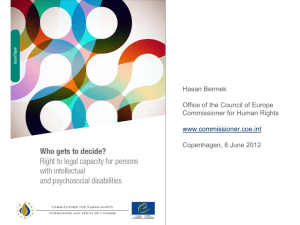COMPARISON OF ADOPTION, LEGAL GUARDIANSHIP/KIN
advertisement
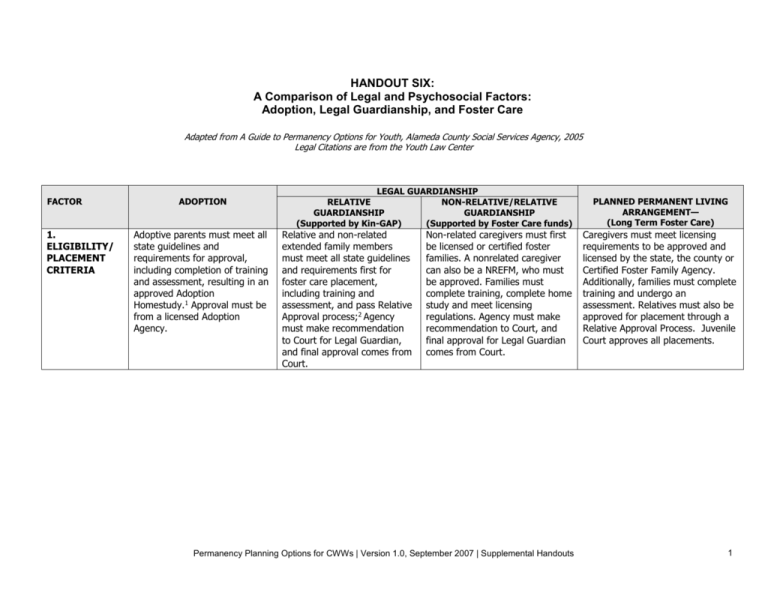
HANDOUT SIX: A Comparison of Legal and Psychosocial Factors: Adoption, Legal Guardianship, and Foster Care Adapted from A Guide to Permanency Options for Youth, Alameda County Social Services Agency, 2005 Legal Citations are from the Youth Law Center FACTOR 1. ELIGIBILITY/ PLACEMENT CRITERIA ADOPTION Adoptive parents must meet all state guidelines and requirements for approval, including completion of training and assessment, resulting in an approved Adoption Homestudy.1 Approval must be from a licensed Adoption Agency. LEGAL GUARDIANSHIP RELATIVE NON-RELATIVE/RELATIVE GUARDIANSHIP GUARDIANSHIP (Supported by Kin-GAP) (Supported by Foster Care funds) Relative and non-related extended family members must meet all state guidelines and requirements first for foster care placement, including training and assessment, and pass Relative Approval process;2 Agency must make recommendation to Court for Legal Guardian, and final approval comes from Court. Non-related caregivers must first be licensed or certified foster families. A nonrelated caregiver can also be a NREFM, who must be approved. Families must complete training, complete home study and meet licensing regulations. Agency must make recommendation to Court, and final approval for Legal Guardian comes from Court. Permanency Planning Options for CWWs | Version 1.0, September 2007 | Supplemental Handouts PLANNED PERMANENT LIVING ARRANGEMENT— (Long Term Foster Care) Caregivers must meet licensing requirements to be approved and licensed by the state, the county or Certified Foster Family Agency. Additionally, families must complete training and undergo an assessment. Relatives must also be approved for placement through a Relative Approval Process. Juvenile Court approves all placements. 1 FACTOR ADOPTION LEGAL GUARDIANSHIP RELATIVE NON-RELATIVE/RELATIVE GUARDIANSHIP GUARDIANSHIP (Supported by Kin-GAP) (Supported by Foster Care funds) 2. ONGOING AGENCY INVOLVEMENT Agency closes child’s case following finalization. Agency is involved only for the provision of AAP, if eligible, or if the family requests, post adoption services may be made available (sees # 11 re: Services Available) Court may dismiss Juvenile Court Dependency following order of Guardianship. If so, no further Agency support or involvement. Support may be available through local Kinship Support Service Centers. If dependency is continued, Agency supervision, case management and Court supervision continues.3 3. RELATIONSHIP Adoptive parents commit to a permanent lifelong relationship with the child. An adopted child becomes their child in all respects. The legal relationship is the same as it is to a child born to them.4 The child’s Court Dependency is dismissed when the adoption is finalized.5 Guardianship suspends the legal rights of birth parents. The guardian(s) have parental responsibility for care, custody, control, and conduct of the child. Court may dismiss Juvenile Court Dependency following order of Guardianship, although technically, court maintains right to supervision of placement. When a family receives foster care funding, they are visited every 6 months by CWW. Court supervision and case management continues if dependency is not dismissed. If child is on SSI and Regional Center client, the Regional Center provides case management. Guardianship suspends the legal rights of birth parents. The guardian(s) have parental responsibility for care, custody, control, and conduct of the child. Permanency Planning Options for CWWs | Version 1.0, September 2007 | Supplemental Handouts PLANNED PERMANENT LIVING ARRANGEMENT— (Long Term Foster Care) Agency continues to hold custody of the child and provides case management services to the child and sometimes to the family. Caregivers must keep license or certification active and are subject to regulations and involvement by the Agency in their home and with the family. While foster parents and relative caregivers provide food, housing and nurturance to a child, the Juvenile Court has legal jurisdiction over the child and the Social Services Agency is responsible for the case management and supervision of the child in the home. 2 FACTOR ADOPTION 4. PERMANENCE Adoption is a lifelong legally binding relationship and provides the highest level of legal permanence.6 The adoptive parent(s) become the legal parents. Birth parents rights are terminated, and birth parents cannot reclaim the child.7 5. PARENTING RIGHTS AND RESPONSIBILITIES Adoptive parents possess all parenting rights and responsibilities for the child.8 LEGAL GUARDIANSHIP RELATIVE NON-RELATIVE/RELATIVE GUARDIANSHIP GUARDIANSHIP (Supported by Kin-GAP) (Supported by Foster Care funds) Guardianship provides permanence, however, it is not as legally secure as adoption; the Court can terminate guardianship, and birth parents can petition the court to terminate the guardianship, or the Legal Guardian may ask the court to dismiss guardianship. Birth parents’ rights are usually not terminated, and birth parents may have the right to visit the child. The Legal Guardian has authority to allow birth parents to be involved in decisions re: the child. Legal guardianship ends at age 18. However, benefits can continue until age 19 as long as youth is attending high school, vocational training full-time or pursuing a GED and is reasonably expected to complete school by their 19th birthday AND continues to live with their KinGAP guardian. Legal Guardians possess parenting rights and responsibilities. When birth parent rights are not terminated, they retain right to visitation. The court can make visitation orders that limit parents' rights.9 PLANNED PERMANENT LIVING ARRANGEMENT— (Long Term Foster Care) Guardianship provides permanence, however it is not as legally secure as adoption. The Court can terminate the guardianship, and birth parents can petition the court to terminate the guardianship, or the Legal Guardian may ask the court to dismiss the guardianship. Birth parents’ rights are usually not terminated, and birth parents may have the right to visit the child. The Legal Guardian has authority to allow birth parent to be involved in decisions re: the child. Legal Guardianship ends at age 18, or may be extended if youth is still in high school. Foster care is meant to be temporary, and does not provide legal permanence for a child. The Agency continues to maintain custody of the child through 18th birthday or until age 19/HS graduation. Court can continue jurisdiction up to age 21. (WIC 303). The birth parents can challenge continuing need for custody in Court. The Agency can remove the child from the caregiver’s home, or the caregiver can request child’s removal. Placement can disrupt at any time. Birth parents rights are generally not terminated, and birth parents maintain right to visit and be involved in major decisions regarding the child, depending on case situation. The Agency makes recommendations to Court regarding the child, and the Juvenile Court makes major decisions. Legal Guardians possess parenting rights and responsibilities. When birth parent rights are not terminated, they retain right to visitation. The court can make visitation orders that limit parents' rights. Caregivers must share parenting rights with the Agency. They must obtain Agency permission for some medical procedures, travel with the child, etc. Agency/Court make major decisions regarding the child. Birth parents may still be involved and may be involved in major decisions regarding the child. Court decides on major medical decisions Permanency Planning Options for CWWs | Version 1.0, September 2007 | Supplemental Handouts 3 FACTOR ADOPTION LEGAL GUARDIANSHIP RELATIVE NON-RELATIVE/RELATIVE GUARDIANSHIP GUARDIANSHIP (Supported by Kin-GAP) (Supported by Foster Care funds) 6. EDUCATIONAL DECISIONS Adoptive parents make all decisions regarding the education of the child. They can request special services from schools, regional centers and any other service provider. Guardians can choose the child’s school and educational program. They can request special services from schools, regional centers and any other service provider. The birth parent may have the right to be involved in school meetings and planning for the child. In special situations, the court may be involved in decisions. Guardians can choose the child’s school and educational program. They can request special services from schools, regional centers and any other service provider. The birth parent may have the right to be involved in school meetings and planning for the child. In special situations, the court may be involved in decisions. 7. CHILD’S RESIDENCE/ MOVES OUT OF COUNTY OR OUT OF STATE Residence is solely determined by the adoptive parents.10 Guardians have the right to move anywhere in state, but must notify the court in writing. An Inter County Transfer must be completed. If the Legal Guardian plans to move out of California, they must obtain court permission and the Legal Guardian is no longer eligible for Kin-GAP funding from California. Guardianship and/or funding may need to be re-established in the new state, subject to the new state’s laws and eligibility rules. Guardians have the right to move anywhere in state, but must notify the court in writing. An Inter County Transfer must be completed. If the Legal Guardian plans to move out of state, they must obtain court permission. Guardianship and/or funding may need to be re-established in the new state, subject to the new state’s laws and eligibility rules. 8. DRIVING/ LICENSE The adoptive parents may sign for the minor’s driver’s license. By signing for the license, the parent’s assume responsibility for insurance coverage. The parent can withdraw consent at The guardian may sign for the minor’s driver’s license. By signing for the license, the parent’s assume responsibility for insurance coverage. The parent can withdraw their The guardian may sign for the minor’s driver’s license. By signing for the license, the parent’s assume responsibility for insurance coverage. The parent can withdraw their consent to the Permanency Planning Options for CWWs | Version 1.0, September 2007 | Supplemental Handouts PLANNED PERMANENT LIVING ARRANGEMENT— (Long Term Foster Care) (see #6 re: Educational Decisions). Unless parental rights are terminated the birth parent retains the right to make critical decisions regarding education for the child, including the right to veto any private or parochial schooling. The child welfare agency and the courts are involved in specific decisions. Foster parents can be appointed as surrogate parents. If parental rights are terminated, the court can limit a parent's educational rights. Legal residence is determined by residence of birth parents. (However, for educational purposes, a foster child may be considered a resident of the location where he or she is placed). The Juvenile Court and the Child Welfare Agency determine where the child lives. Courtesy supervision is arranged when a child moves w/ caregiver out of county or out of state. Interstate Compact Program rules must be followed when a child moves out of state and licensing/certification procedures for that state must be followed. Youth is required to file proof of financial responsibility. A responsible adult can sign the DMV application; liability issues may be of concern. 4 FACTOR ADOPTION any time.11 LEGAL GUARDIANSHIP RELATIVE NON-RELATIVE/RELATIVE GUARDIANSHIP GUARDIANSHIP (Supported by Kin-GAP) (Supported by Foster Care funds) PLANNED PERMANENT LIVING ARRANGEMENT— (Long Term Foster Care) consent to the license at any time.12 A guardian may consent to the enlistment of a minor.14 license at any time. Both the court and the relative guardians must give consent to the marriage of the minor child.16 Both the court and the guardians must give consent to the marriage of the minor child.17 The family is eligible for services available for any family receiving TANF funding. If dependency is dismissed, Agency no longer provides support. Support may be available through local kinship centers. Guardianship terminates in the event of death of the guardian. Birth parents may attempt to regain custody. The court may appoint a successor guardian or reestablish dependency and place the child in foster care. The Court may ask the Guardian to agree to other special agreements concerning the child’s welfare. When dependency is dismissed, the Agency continues to provide support, through resource and referral, and home visits every 6 months. If court dependency continues, child continues to be eligible for services through the Agency. Guardianship terminates in the event of death of the guardian. Birth parents may attempt to regain custody. The court may appoint a successor guardian or re-establish dependency and place the child in foster care. Child and caregiver eligible for services through the Agency. Agency provides supervision, case management and crisis intervention services. The Court may ask the Guardian to agree to other special agreements concerning the child’s welfare. Caregivers must follow Agency and Court directions re: visitation and supervision. They must be accountable for any funds received on behalf of the child. They must adhere to Court orders. Permanency Planning Options for CWWs | Version 1.0, September 2007 | Supplemental Handouts 5 9. ARMED SERVICES 10. MARRIAGE OF MINOR CHILD The adoptive parents may consent to the enlistment of a minor.13 Adoptive parents may consent to marriage of their minor child.15 11. SERVICES AVAILABLE The adoptive family is eligible for post-adoption services, which may include providing resource and referral brief case management, and crisis intervention. 12. DEATH OF CAREGIVER The adopted child is treated the same as a birth child. The adoptive parents can designate in their will who will raise the child in the event of their death.19 AAP funding can only be paid to an adoptive parent. 13. SPECIAL CONDITIONS/ COURT JURISDICTION If adoptive parents agree, a post adopt mediation may occur prior to the adoption and plan may be ordered at the adoption regarding visitation/contact with birth parents and/or relatives. A guardian may consent to the enlistment of a minor. The Juvenile Court retains the responsibility to consent to the enlistment of a minor. The Juvenile Court maintains the responsibility to consent to the marriage of a minor under its jurisdiction.18 The Social Services Agency retains placement authority and must locate another living arrangement for the child. FACTOR 14. INDEPENDENT LIVING SKILLS PROGRAM (ILSP) ELIGIBILITY ADOPTION Youth adopted after their 16th birthday may participate in ILSP programs, except for Housing Assistance Programs. (Refer to Financial Comparison chart) LEGAL GUARDIANSHIP RELATIVE NON-RELATIVE/RELATIVE GUARDIANSHIP GUARDIANSHIP (Supported by Kin-GAP) (Supported by Foster Care funds) Youth under relative Legal Guardianship after their 16th birthday may participate and benefit from all ILSP programs.20 Youth under relative and nonrelative Legal Guardianship after their 16th birthday may participate and benefit from all ILSP programs. Permanency Planning Options for CWWs | Version 1.0, September 2007 | Supplemental Handouts PLANNED PERMANENT LIVING ARRANGEMENT— (Long Term Foster Care) Youth who remain in Foster care may participate and benefit from all ILSP services.21 6
